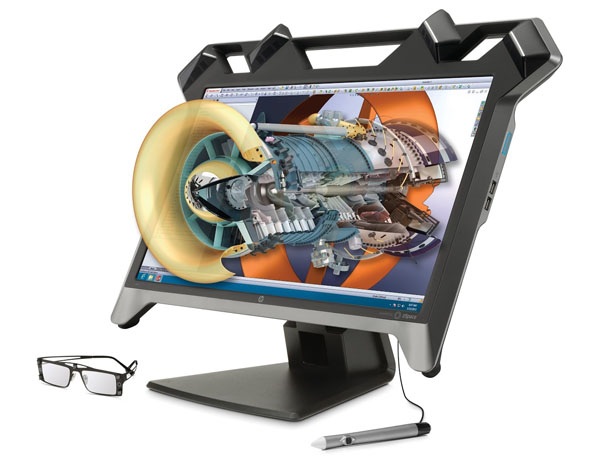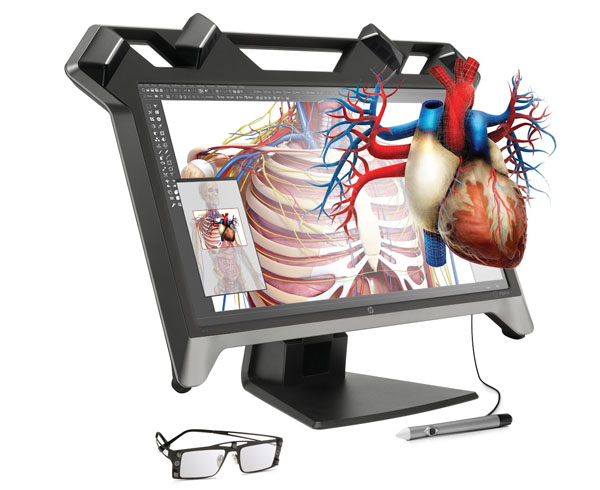HP Debuts Virtual Reality Display At CES
Fans of the movie Minority Report have no doubt hoped that one day they'd be able to interact with a computer the same way Tom Cruise did, by manipulating virtual objects in real time with hand and eye movements. HP brings that dream closer to fruition with the Zvr Virtual Reality display.
The Zvr goes far beyond a typical 3D display where you merely view the image; tracking sensors located in the users' glasses as well as the screen's bezel tie your head movements to the action on the screen. You turn your head and the image moves with you, free of lag or parallax distortion. Further object manipulation is possible with the included stylus. You can literally interact with a virtual object as if it were sitting right in front of you.
This is potentially a great tool for presenters. You call up an object -- say, a part you've designed. As you turn it over on your virtual 3D desktop, other viewers can see a 2D facsimile projected onto their displays or perhaps a projector. That function will be enabled by add-on hardware shipping in Q2 2015.
Spec-wise, the Zvr is built around a 23.6-inch TN screen with 1920 x 1080 pixel resolution. A fairly quick 5 millisecond response time should minimize input lag. The extra-large bezel is fitted with four infra-red cameras that interact with five sensors in the included 3D glasses. Also in the package is a stylus that can be used to move objects around the screen in real time. Inputs include one each of DVI (with HDCP) and DisplayPort 1.2. There is also a USB 2.0 hub with three outputs.
HP is positioning the Zvr as a presentation product, and we can see its suitability for that application. The product photos suggest a collaborative use where professionals can manipulate objects as they discuss design or procedure. With 3D imaging already a part of advanced medicine, doctors could confer at one or multiple locations as they develop new lifesaving techniques. And it's the perfect tool for engineering and design groups who often have to work in teams to accomplish their goals. And how about architecture or interior design? One could feasibly walk through a building and interact with doors, windows and other objects, all without leaving their office.
We're also hoping game developers will pick up on the possibilities and perhaps try creating titles that offer an alternative to typical VR headsets that only manipulate the environment itself, not the objects within it. How about a three-dimensional puzzle (like a Rubik's cube) that exists in virtual space? Or a virtual reality version of the escape room attractions that are currently all the rage? Imagine a team of players all networked with Zvr displays working together to solve a mystery or escape from a room using virtual objects and solving puzzles.
Pricing and availability were unavailable at press time but are expected sometime in Spring 2015.
Get Tom's Hardware's best news and in-depth reviews, straight to your inbox.
Follow us @tomshardware, on Facebook and on Google+.

Christian Eberle is a Contributing Editor for Tom's Hardware US. He's a veteran reviewer of A/V equipment, specializing in monitors. Christian began his obsession with tech when he built his first PC in 1991, a 286 running DOS 3.0 at a blazing 12MHz. In 2006, he undertook training from the Imaging Science Foundation in video calibration and testing and thus started a passion for precise imaging that persists to this day. He is also a professional musician with a degree from the New England Conservatory as a classical bassoonist which he used to good effect as a performer with the West Point Army Band from 1987 to 2013. He enjoys watching movies and listening to high-end audio in his custom-built home theater and can be seen riding trails near his home on a race-ready ICE VTX recumbent trike. Christian enjoys the endless summer in Florida where he lives with his wife and Chihuahua and plays with orchestras around the state.
-
mapesdhs This kind of interaction isn't new. I was an admin for a VDesk6 more than 10 yearsReply
ago which offers similar functionality. What's changed is getting the technology
cheaper, better quality, faster, easier to use, etc.
Ian.

